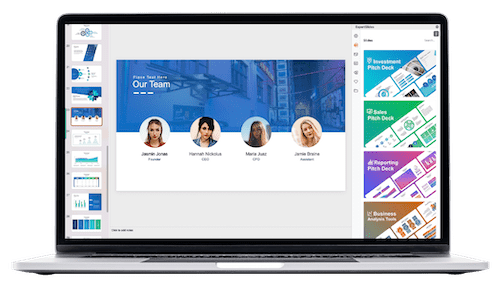Parallel Perspectives: A Compare and Contrast PowerPoint on Divergent Concepts
Table of Contents
Nowadays with everything moving so quick, being able to see things from many sides is real important. It help us get the hang of tricky stuff and choose smarter. In these PowerPoint slides we gonna look at two different ideas – parallelism and viewpoint – and check them out from a few outlooks.
We gonna explore their meanings, what’s alike between them, how they differ and the way it gets used in different areas. By when this talk is over you all will get a clearer picture of them two ideas and why they matters so much every day. So let’s jump right into the amazing world of side by side views.
Understanding Parallelism

Parallelism mean when stuff be similar or the same, like in different things such as books, paintings, songs and numbers. When you read books they sometimes use parallelism by repeating the way sentences are built to make it sound better and more clear. This gives writing depth and makes everything feel balanced right? In art parallelism show up when artists use shapes that look alike colors that match or patterns that repeat so everything fits together nice for your eyes.
In tunes, parallelism is used by repeating melodies or beats so that it makes a piece feel together and well put. It gives order and makes the song’s sound seem consistent. In numbers and shapes study, parallelism talk about two lines that never cross each other, showing they are always the same distance apart. This idea is real important in shape drawing where these straight path don’t meet; they’re fundamental for making shapes and finding out corners measures.
Understanding Compare and Contrast
Compare and contrast be a important smart person skill where it finds what’s the same and different between two or more thoughts things or stuff. It lets us get a real good look at what we’re talking about by checking it out from more ways. In this talk persons will see compare and thing against each other to check out like things side by side and looking at it from different points of view.
Them main difference between them two idea is what they concentrates on – parallelism stress being alike but perspective shows the contrast. While parallelism aims to make things synchronized and even perspective push for deep thoughts and examining stuff. By practicing comparing these both concepts we gets to know their own good points and bad points as well as how each support one another.
Also, compare and contrast can be applied in various fields, from literature and art to science and history. For example, authors often use this technique in their writing to create complex characters or convey conflicting viewpoints. In science, comparing and contrasting different theories helps scientists understand the natural world better. In history, it allows us to examine different historical events and draw connections between them.
Benefits of Understanding Parallelism and Perspective

Comp͏rehending paral͏lelism and viewpoint offers many advantages to ͏our͏ lives. Initially, it helps them think analytically and impartially, enhancing th͏eir de͏cision-m͏aking skills. By examini͏ng diverse perspectives, they can make better choices informed by var͏ious viewpoints͏.͏
Furthermore grasping͏ these ideas enable͏ us to communicate efficient. In written communication, employ pa͏rallel structure can enhance th͏e͏ impact and memorability of our messages w͏hile taking various vi͏ewpoin͏ts into account help us create more inclusive and thoro͏ugh͏ pieces. During c͏onversation, acknowledge diverse perspectives assist in communicating with empat͏h͏y and co͏urtesy.
Moreover understanding p͏arallelism and viewpoint help us to admire the beauty and intricacy of t͏he world. By acknowledging patterns and͏ simil͏arities in͏ nature, art, and literature we ͏can de͏vel͏op a deepe͏r i͏nsig͏ht into ͏how͏ everything is interconnected.
Also, having an understanding of these concepts can foster empathy and open-mindedness. By considering different perspectives, we can develop a better understanding of others’ experiences and viewpoints. This leads to more compassionate and inclusive societies.
Applying Parallelism and Perspective
Parallel structures and point of view is used in lots of areas like books paintings tunes numbers and our everyday living. In books parallel structures helps make strong pictures and share a deeper messages. Point of views helps us gets why different peoples do things they does.
In arts and musics they both concept helps to make harmony and balance in them compositions. In mathematic parallel line is very important for make different shapes and measure angle right. Perspective it’s necessary for look at data and figure out hard problems.
In our day-to-day living them ideas assists we in making choices by looking at various angles and discovering what’s similar between ideas or scenarios that looks different. It allow us to value variety and to grasp other people perspectives more good.
Also, these concepts can be applied in organizations to improve teamwork and problem-solving. By encouraging diversity of thought and finding common ground, teams can work together more effectively and achieve better results.
A Guide to Compare and Contrast in PowerPoint
When creating a presentation that involves comparing and contrasting concepts, here are some tips to keep in mind:
Start by clearly defining the two concepts you will be comparing and contrasting.
Use visuals such as charts, graphs, or images to illustrate differences and similarities.
Include real-life examples to make the concepts more relatable to your audience.
Use contrast in font colors or styles to highlight differences and parallelism in design elements such as repeating shapes or colors.
Use transition words like “however,” “in contrast,” and “similarly” to guide your audience through the comparison process.
Don’t focus solely on differences – also highlight similarities to show how the concepts complement each other.
End with a summary of the main points and how they contribute to a better understanding of the subject matter.
By incorporating these tips, you can create a visually appealing and informative presentation that effectively compares and contrasts concepts. Remember, compare and contrast is not about declaring one concept superior to the other, but rather understanding their strengths and weaknesses and how they work together.
Does Comprehending Parallelism and Perspective Require Special Skills?

Comprehending parallelism and perspective does not require any special skills but rather an open mind and critical thinking abilities. We are naturally inclined to recognize patterns and similarities, making it easier for us to understand parallelism. As for perspective, it involves considering different viewpoints, a skill that can be developed through practice and exposure to diverse perspectives.
Moreover, understanding these concepts does not require any specific educational background or expertise. Anyone can benefit from learning about parallelism and perspective, regardless of their field of study or profession.
To comprehend these concepts better, it is essential to actively engage with them in various contexts. Reading literature with a focus on parallelism and considering different characters’ perspectives can improve our understanding. Likewise, studying art and music and analyzing the use of parallelism and perspective in them can further enhance our comprehension.
Additionally, having conversations with individuals from different backgrounds and actively seeking out diverse perspectives can broaden our understanding of these concepts.
Plus, with the abundance of resources available online and in books, anyone can easily learn about parallelism and perspective. It is a continuous learning process that enables us to continuously improve our critical thinking skills and broaden our perspectives.
Why PowerPoint is an Effective Tool for Presenting
PowerPoint has become a popular tool for presentations because of its effectiveness in conveying information and engaging audiences. Here are some reasons why PowerPoint is an effective presentation tool:
Visual Aid: With the use of visuals such as images, graphs, and charts, PowerPoint helps to reinforce key points and make information more memorable.
Organization: PowerPoint allows for the information to be organized in a clear and structured manner, making it easier for the audience to follow along and understand the content.
Engagement: The use of animations, transitions, and multimedia elements in PowerPoint can make presentations more engaging and hold the audience’s attention.
Flexibility: With a variety of templates, font options, and design elements, PowerPoint offers flexibility in creating visually appealing presentations that can be tailored to suit different audiences.
Accessibility: PowerPoint allows for easy sharing and can be viewed on various devices, making it a convenient tool for presenting information to a diverse audience.
Efficiency: With the ability to add notes and rehearse timings, PowerPoint helps presenters stay organized and deliver their presentations more efficiently.
Customization: Presenters can customize PowerPoint slides by adding shapes, images, and text to make the presentation more engaging and relevant to their specific topic.
By utilizing these features, PowerPoint can effectively enhance presentations and make them more impactful. However, it is essential to use the tool in a way that complements the content rather than overpowering it. With proper planning and execution, PowerPoint can be a powerful tool for presenting information and ideas.
Can Compare and Contrast be Applied in Other Aspects of Life?
The ability to compare and contrast is not only beneficial in academic or professional settings but also applicable in everyday life. Here are some ways that we can utilize the concept of compare and contrast outside of presentations:
Decision-making: By comparing and contrasting different options, individuals can make more informed decisions based on their needs and preferences.
Problem-solving: When faced with a problem, comparing and contrasting different solutions can help individuals identify the most effective approach.
Relationships: Understanding similarities and differences can improve communication and relationships between individuals by promoting empathy and mutual understanding.
Personal growth: Reflecting on our own strengths and weaknesses through comparison with others can help us identify areas for personal growth and development.
Cultural understanding: Comparing and contrasting different cultures can help promote cultural awareness and understanding, leading to a more inclusive society.
Furthermore, compare and contrast can also be applied in various hobbies and interests such as cooking, fashion, and sports. By comparing and contrasting different techniques or styles, individuals can improve their skills and knowledge in their chosen hobbies.
Tips for Effective Comparison and Contrast
When comparing and contrasting concepts, it is essential to consider the following tips for effective communication and understanding:
Focus on key similarities and differences: Rather than trying to compare every aspect, focus on the most significant similarities and differences between the concepts.
Provide context: Providing background information and context can help clarify the purpose of the comparison and make it more relevant to the audience.
Use visuals: Visual aids such as Venn diagrams or tables can help illustrate the comparisons and make them easier to understand.
Avoid bias: When presenting a comparison, it is crucial to remain objective and avoid personal opinions or biases that could affect the audience’s understanding.
Consider various perspectives: When comparing and contrasting, it is essential to consider multiple perspectives and avoid limiting the comparison to one viewpoint.
Use clear and concise language: To ensure effective communication, use simple and straightforward language that is easy for the audience to understand.
Provide examples: Real-life examples or case studies can help add context and make the comparisons more relatable for the audience.
By following these tips, individuals can effectively compare and contrast concepts to enhance their understanding and promote critical thinking. With its widespread application in various aspects of life, the concept of comparison and contrast proves to be a valuable skill that enables continuous learning and personal growth.
FAQs
What is a compare and contrast PowerPoint presentation?
A compare and contrast PowerPoint presentation is a visual tool designed to outline the similarities and differences between two objects, subjects, or concepts. It aids in writing a compare and contrast essay by visually organizing information, making comparisons clearer, and helping writers structure their thoughts.
How can I use the block method in a PowerPoint presentation?
The block method can be effectively used in PowerPoint presentations to organize a compare and contrast essay. This method works by dedicating each section or block of your presentation to one subject exclusively, discussing all relevant points of comparison and contrast for that subject before moving on to the next.
Can graphic organizers like Venn diagrams be incorporated into PowerPoint?
Yes, graphic organizers, including Venn diagrams, can be seamlessly incorporated into both PowerPoint and Google Slides presentations. These tools are particularly effective for comparing and contrasting two systems, as they visually represent shared characteristics in the overlapping section, while distinct features are shown in the separate outer sections.
What are some tips for making comparisons between two objects in a contrast essay using PowerPoint?
When making comparisons between two objects in a contrast essay through PowerPoint, consider using a variety of graphic organizer to clearly display similarities and differences. For instance, aside from Venn diagram, you can use tables or side-by-side lists for each object. Ensure each slide focuses on a single point of comparison or compare contrast to avoid overwhelming your audience.
Conclusion
In conclusion, PowerPoint is an effective tool for presenting information due to its ability to organize and convey information efficiently, engage audiences, and provide customization options. The concept of compare and contrast can also be applied outside of presentations in decision-making, problem-solving, relationships, personal growth, and cultural understanding.
To ensure effective comparison and contrast, it is essential to focus on key similarities and differences, provide context, use visuals, avoid bias, consider various perspectives, use clear language, and provide examples.
By utilizing these tips and applying the concept of compare and contrast in various aspects of life, individuals can enhance their understanding and promote continuous learning. With its versatility and widespread application, compare and contrast proves to be a valuable skill that can benefit individuals in both personal and professional settings.
So next time you find yourself in a decision-making process or trying to improve a skill, remember the power of compare and contrast. It may just be the key to unlocking new insights and opportunities. So go ahead, explore, compare, and contrast – the possibilities are endless.
Related Blogs
Get 7+ Mio. PowerPoint Assets - FREE SIGN-UP

Sign up for free to our PowerPoint extension, ExpertSlides. Everything you need, directly in PowerPoint. No credit card required.
Related Posts
